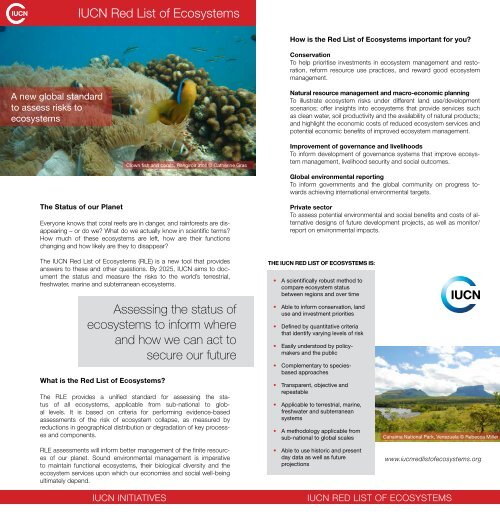Create successful ePaper yourself
Turn your PDF publications into a flip-book with our unique Google optimized e-Paper software.
IUCN Red List of Ecosystems<br />
How is the Red List of Ecosystems important for you?<br />
Conservation<br />
To help prioritise investm<strong>en</strong>ts in ecosystem managem<strong>en</strong>t and restoration,<br />
reform resource use practices, and reward good ecosystem<br />
managem<strong>en</strong>t.<br />
A new global standard<br />
to assess risks to<br />
ecosystems<br />
Natural resource managem<strong>en</strong>t and macro-economic planning<br />
To illustrate ecosystem risks under differ<strong>en</strong>t land use/developm<strong>en</strong>t<br />
sc<strong>en</strong>arios; offer insights into ecosystems that provide services such<br />
as clean water, soil productivity and the availability of natural products;<br />
and highlight the economic costs of reduced ecosystem services and<br />
pot<strong>en</strong>tial economic b<strong>en</strong>efits of improved ecosystem managem<strong>en</strong>t.<br />
Clown fish and corals, Rangiroa atoll © Catherine Gras<br />
Improvem<strong>en</strong>t of governance and livelihoods<br />
To inform developm<strong>en</strong>t of governance systems that improve ecosystem<br />
managem<strong>en</strong>t, livelihood security and social outcomes.<br />
Global <strong>en</strong>vironm<strong>en</strong>tal reporting<br />
To inform governm<strong>en</strong>ts and the global community on progress towards<br />
achieving international <strong>en</strong>vironm<strong>en</strong>tal targets.<br />
The Status of our Planet<br />
Everyone knows that coral reefs are in danger, and rainforests are disappearing<br />
– or do we? What do we actually know in sci<strong>en</strong>tific terms?<br />
How much of these ecosystems are left, how are their functions<br />
changing and how likely are they to disappear?<br />
Private sector<br />
To assess pot<strong>en</strong>tial <strong>en</strong>vironm<strong>en</strong>tal and social b<strong>en</strong>efits and costs of alternative<br />
designs of future developm<strong>en</strong>t projects, as well as monitor/<br />
report on <strong>en</strong>vironm<strong>en</strong>tal impacts.<br />
The IUCN Red List of Ecosystems (RLE) is a new tool that provides<br />
answers to these and other questions. By 2025, IUCN aims to docum<strong>en</strong>t<br />
the status and measure the risks to the world’s terrestrial,<br />
freshwater, marine and subterranean ecosystems.<br />
Assessing the status of<br />
ecosystems to inform where<br />
and how we can act to<br />
secure our future<br />
What is the Red List of Ecosystems?<br />
The RLE provides a unified standard for assessing the status<br />
of all ecosystems, applicable from sub-national to global<br />
levels. It is based on criteria for performing evid<strong>en</strong>ce-based<br />
assessm<strong>en</strong>ts of the risk of ecosystem collapse, as measured by<br />
reductions in geographical distribution or degradation of key processes<br />
and compon<strong>en</strong>ts.<br />
RLE assessm<strong>en</strong>ts will inform better managem<strong>en</strong>t of the finite resources<br />
of our planet. Sound <strong>en</strong>vironm<strong>en</strong>tal managem<strong>en</strong>t is imperative<br />
to maintain functional ecosystems, their biological diversity and the<br />
ecosystem services upon which our economies and social well-being<br />
ultimately dep<strong>en</strong>d.<br />
THE IUCN RED LIST OF ECOSYSTEMS IS:<br />
• A sci<strong>en</strong>tifically robust method to<br />
compare ecosystem status<br />
betwe<strong>en</strong> regions and over time<br />
• Able to inform conservation, land<br />
use and investm<strong>en</strong>t priorities<br />
• Defined by quantitative criteria<br />
that id<strong>en</strong>tify varying levels of risk<br />
• Easily understood by policymakers<br />
and the public<br />
• Complem<strong>en</strong>tary to speciesbased<br />
approaches<br />
• Transpar<strong>en</strong>t, objective and<br />
repeatable<br />
• Applicable to terrestrial, marine,<br />
freshwater and subterranean<br />
systems<br />
• A methodology applicable from<br />
sub-national to global scales<br />
• Able to use historic and pres<strong>en</strong>t<br />
day data as well as future<br />
projections<br />
Canaima National Park, V<strong>en</strong>ezuela © Rebecca Miller<br />
www.iucnredlistofecosystems.org<br />
IUCN INITIATIVES<br />
IUCN RED LIST OF ECOSYSTEMS


















